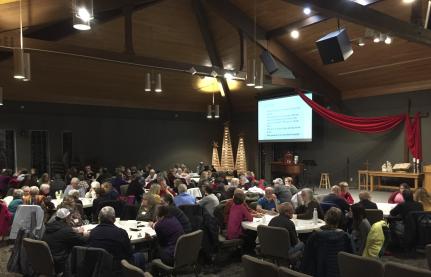Although the Supreme Court’s landmark 2015 ruling in Obergefell vs. Hodges seemed to settle many civil issues about same-sex marriage in the United States, the topic remains contentious in many religious communities. In recent years, some denominations have broken with the historical Christian view that same-sex relations “miss the mark” and have become more LGBTQ affirming. Many have not, however, meaning they will not support “unrepentant” same sex sexual behavior or same-sex marriage in their churches.
From February 23-26, 2019, another major denomination will meet to discuss its official stance about same-sex relations, as leaders in the United Methodist Church will convene in St. Louis, Missouri to discuss “a way forward.” The plan recommended by the Methodist Council of Bishops would allow local decision-makers to implement policies about matters such as same-sex marriage that best fit their social contexts. If approved, this would enable more progressive districts to support the ordination of gay and lesbian Pastors and marry same-sex couples, subject to the conscience of the local pastor, while allowing more conservative districts to remain unchanged in policy and practice.
At play in these deliberations are questions of how to know what is true about matters of faith. The founder of the Methodist tradition – John Wesley – proposed four “ways of knowing,” now organized in what is popularly termed the “Wesleyan Quadrilateral:” experience, reason, tradition, and Scripture. Basically, Methodists look for “converging evidence” in these four domains when creating church policy, although Scripture is prioritized.

As a psychological scientist, I have found an understanding of Psychology to be helpful in this work. For instance, in the Wesleyan Quadrilateral, psychology illuminates how individuals may differ in interpreting experience, tradition, and Scripture. More centrally, part of “reason” is “science,” and so insights from psychological science often have taken center stage in this group’s discussions.
For example, many group members were surprised to learn about the connection between religion and suicidality among sexual minorities. In particular, in one study of over 20,000 young adults, researchers found a link between the importance ascribed to religion in participants’ lives and the amount of suicidal thinking among those identifying as gay, lesbian, or questioning.
In a session devoted almost entirely to science, we explored what research has revealed about the causes of sexual orientation and the changeability of sexual orientation. I assigned chapters from two books, reflecting both conservative and progressive perspectives. Doing this allowed us to focus on where psychologists with different theological positions agreed:
- 2-3% of the population reports being consistently and exclusively attracted to members of the same sex (more males than females).
- Sexual orientation is complex and poorly understood. There is no single cause.
- Part of what determines sexual orientation seems to be a genetic predisposition.
- Prenatal hormones seem to play a role in determining sexual orientation, at least in animal models.
- Poor parent-child relationships – including history of childhood abuse – do not seem to predict sexual orientation.
- Sexual orientation is not chosen; sexual behavior is.
- Most – if not all – people will not substantially change their sexual orientation.
Psychological research suggested ways to encourage constructive dialog as well. Applying a tactic similar to the “jigsaw classroom,” I randomly assigned group members to tables during the more discussion-oriented sessions. This ensured that individuals were not self-selecting into groups with others who would further confirm their positions, but rather share views that would provoke deeper thought. We also often replied upon “ground rules” for conversation, including the importance of using “I statements” that required individuals to take ownership of their positions rather than asserting their universal truth value.
In our last session, most people noted that they did not change their beliefs very much as a result of their participation. What was almost universally agreed upon, though, was how complicated this issue was, and therefore how much intellectual humility is necessary. Many people reported how learning from both sides stretched them and helped them gain greater empathy toward those with whom they differed. Individuals reported growing spiritually and wanting to be a member of this church, which stood out in being willing to willingly embrace this kind of complexity.
Spiritually, leading this group reminded me of several core convictions. First, it returned me to Thomas Merton’s beautiful prayer that, even if I don’t always know what I believe or what I’m doing or what the fruit of my labors will be, the desire to please God matters. Second, the group continually raised to mind the core Christian teaching of loving one’s neighbor as one’s self and how difficult that can sometimes be, particularly when dealing with differences in core identity. As Rabbi Jonathan Sacks once said, “the supreme religious challenge is to see God’s image in the one who is not in our image.” Finally, I learned, again, to appreciate the value of mystery and questioning as a Christian. As theologican and author Barbara Brown Taylor put it:
“If it is true that God exceeds all our efforts to contain God, then is it too big a stretch to declare that dumbfoundedness is what all Christians have most in common? Or that coming together to declare all that we do not know is at least as sacred an activity as declaring what we think we do know?”
More broadly, I felt like leading a group on such a contentious, politicized issue with people I know and like was a huge risk. After the first session, my wife wondered aloud with me whether we were going to make enemies of everyone we knew! However, the group taught me to learn how to trust that good is still possible and that, with a little guidance and encouragement, most people really are capable of open, respectful conversation.
That’s a lesson we all need to remember.
This post was adapted from an article for http://www.psychologytoday.com.
Advertisements